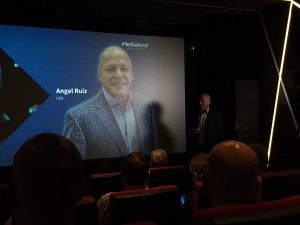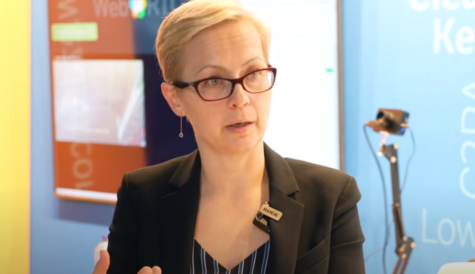
After more than 40 years of operation, DTVE is closing its doors and our website will no longer be updated daily. Thank you for all of your support.
The birth of MediaKind

Angel Ruiz presenting the new brand
One small step for Ericsson, one giant leap for MediaKind. Ericsson Media Solutions’ rebrand this week ahead of completion of the carve-out that will see One Media Partners take a 51% stake in the venture came after “a lot of input” from the company’s employees, according to chief marketing officer Arun Bhikshesvaran.
The brand is intended to convey both a laser-like focus on media and a simultaneous broadening of the concept of the scope of media beyond entertainment. The tagline below the new MediaKind logo is ‘everyone. everywhere’.
Ericsson’s disposal of a majority stake in its media solutions business is often seen as a cautionary tale alongside Cisco’s exit from the pay TV solutions business.
In Cisco’s case, the sale of its set-top business to Technicolor in 2015 was followed by the ongoing Permira-backed acquisition of the former NDS business, which, like One Media Partners’ acquisition of a majority stake in MediaKind, is expected to complete later this year.
Ericsson, unlike Cisco, has retained a foothold in its media businesses. Last year it split off its broadcast and media services unit into a separate business under the revived Red Bee brand after earlier splitting the media operations into two parts in order to “explore strategic opportunities” for the businesses.
In the case of MediaKind, Ericsson’s and the new business’s strategy seems be based on three key precepts.
First, Ericsson, despite being unable to really make a success of its media investments as originally envisaged, remains convinced of the case for convergence of media and mobility.
The company’s own regular Mobility Reports forecast that half of all TV and video viewing will be via a mobile screen by 2020, due to the increasing consumer preference for on-demand and catch-up TV over linear viewing. Ericsson has predicted that mobile video traffic will grow by around 50% annually through 2023 to account for 75% of all mobile data traffic.
Video is likely therefore to be a major driver for 5G. Ericsson expects major 5G deployments globally from 2020, anticipating more than one billion connections for enhanced mobile broadband by the end of 2023.
During MediaKind’s launch presentation in London this week, CEO Angel Ruiz claimed that the new outfit would have “a combination of media and mobility that I don’t think anyone else in the market has today” and highlighted a vision where people could consume entertainment seamlessly on the move, shifting from screen to screen as they enter their homes.
The new company’s management team is distinctly mobile-focused with both Bhikshesvaran and COO Gowton Achaibar having strong mobility experience.
Second, Ericsson’s and MediaKind’s management are aware of the need for further consolidation in the media technology business, particularly in segments such as video compression, where Ericsson, despite being one of the bigger players, has no more than about a 12% share in any single market, in Ruiz’s estimation.
Being aware of a need for consolidation is one thing. Being willing and able to lead and finance it is another. Lest we forget, Ericsson’s credit rating was cut to junk status by Moody’s last year on a poor earnings outlook and cash flow expectations in the face of tough competition in its markets. Having private equity take up the baton while retaining a minority stake could therefore be seen as a sensible move for both parties.
Third, as mentioned earlier, the new brand is intended to convey the idea that the proper study of MediaKind is media, to paraphrase Alexander Pope. But what is media? The other pillar in MediaKind’s strategic thinking is that much fresh growth will come from areas unrelated to video as pure entertainment.
Private equity investors love cash flow from an established customer base, and the new company will of course continue to serve its large pool of existing pay TV and broadcast customers, as well as targeting the higher growth OTT TV segment.
However, during the launch presentation, MediaKind’s management singled out smart cities and the Internet of Things as key opportunities going forwards.
Ruiz said that city officials all over the world are interested in how video is going to help deliver the smart city and smart services of the future. “From our perspective, being media and video focused means being entertainment focused. But when you talk about where video is in 2025, the amount of video that will not be entertainment but will be about safety and security and city administration will be phenomenal,” he said.
Again, an ongoing tie-in with Ericsson could make sense in targeting this emerging market.
So there we have it: three pillars on which to build a sustainable and growing business. Only time will tell whether MediaKind lives up to its promise.


